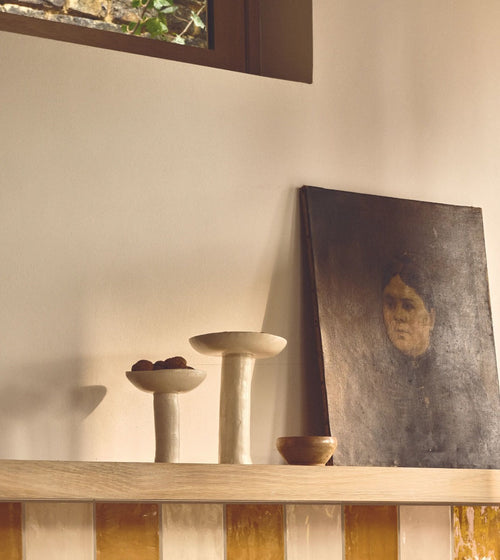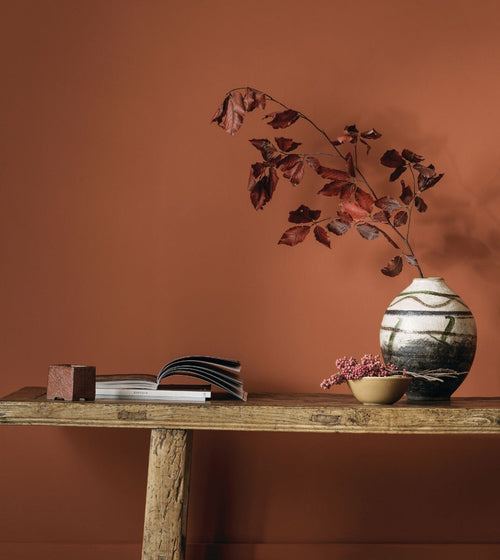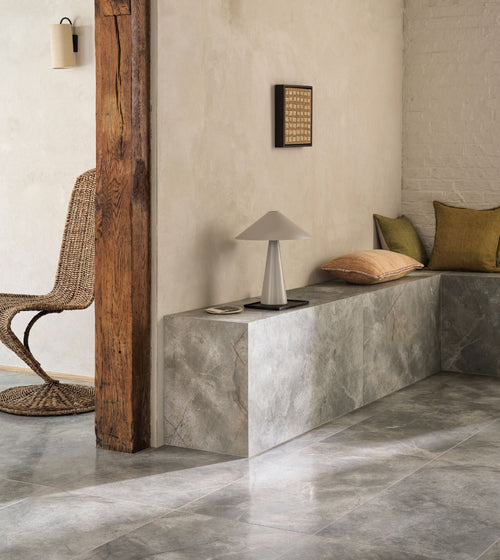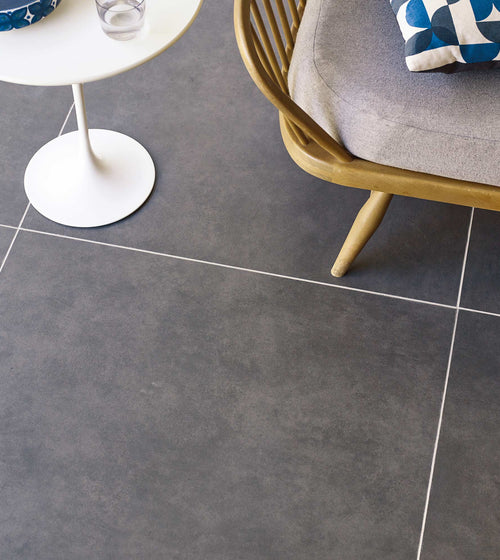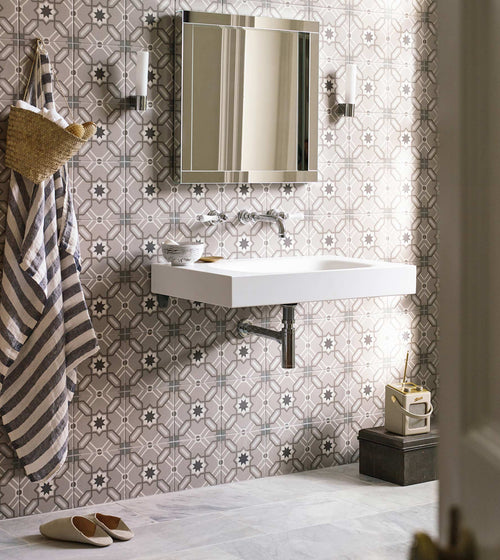How much do bathroom wall tiles cost? | Comparing the different bathroom tile material costs
Whether you're planning on tiling a bright and busy family bathroom, a contemporary spa-style shower room, or a beautifully classic country bathroom, wall tiles offer endless scope for creativity. Available in countless materials, formats and finishes – and with options for a wide range of budgets – bathroom tiling is a truly practical choice, protecting the walls from damp air and splashes.
This guide will explore the factors that affect the cost of bathroom wall tiles, compare different tile materials, and provide insights on what you should consider before buying.
Click on the link to jump to that section:
Read more on the various factors that may alter the cost of bathroom wall tiles.
Discover the price range of various bathroom wall tile materials.
Explore the different shapes and sizes available for bathroom walls, and their costs.
Find out other expenses of tiling a bathroom wall, including grout, adhesive, and tile installation.
Discover who Fired Earth are, and how they can help find your ideal bathroom wall tile.
Read the most common questions asked about the cost of bathroom wall tiles.
What may affect the cost of bathroom wall tiles?
It is important to consider several factors that may influence the overall cost of bathroom wall tiles:
Type of tile material
Tile materials vary in porosity, which is their capacity to absorb water and other liquids, such as shampoo and shower gel. Bathroom wall tiles must be as non-porous as possible, particularly when used on shower walls, where water will regularly stream down them. Consider materials such as glass, ceramic, and porcelain tiles, which are virtually non-porous and a low-maintenance choice.
While most wall tiles are suitable for bathroom use, checking the walls' weight-bearing capacity is essential since materials, such as stone, can be extremely heavy.
Size of the bathroom wall
Fired Earth's online calculator will calculate the required bathroom tiles, including a wastage allowance, for any given area. It is vital to always take time to measure the bathroom wall as accurately as possible for optimum results.
Contact Fired Earth today to learn more about how we can help you.
Where will the tiles be needed?
Different bathroom areas may affect the choice and cost of wall tiles. Consider where the tiles are needed in the bathroom and other factors, such as their practicality, budget and aesthetics. Examples include a protective splashback behind a basin, shower walls, or to create a wet room.
Always check the suitability of tiles for bathrooms, particularly if the tiles are to be extended from the wall onto wet room floors, as slip resistance is an important consideration.
At Fired Earth, we provide bathroom tiles designed to create a perfect spa-like experience on shower walls.
Discover our bathroom tiles for shower walls here.
The size of the tiles
While the size of wall tiles tends to have little bearing on the price, small-format and mosaic tiles may be more time-consuming to lay and may require larger quantities of ancillary products, such as adhesive and grout.
Browse through our range of fixing and maintenance products here.
How much do bathroom wall tiles cost?
There are options for every bathroom style and a wide range of budgets. Here are some of the most popular options, along with their approximate price ranges:
Glazed and decorated
These bathroom tiles start from as little as around 50p per tile. However, for handmade and intricate designs, you can expect to pay several hundred pounds per square metre, with a vast and inspiring range of options in between. With a little imagination, even the simplest and most inexpensive white metro-style tiles can create eye-catching bathroom walls.
The Architecture range fuses classic elegance with clean, structural style, and has a glazed finish. It is suitable for bathroom and shower walls.
Browse through the entire range of glazed wall tiles suitable for bathrooms here.
Porcelain and ceramic
Porcelain and ceramic tiles are available in an extensive selection of formats and finishes, offering many low-maintenance yet stylish options for bathroom walls.
Designs range from remarkably realistic-looking replica stones, terrazzo and wood to metallic-effect finishes and beautiful decorative tiles that combine timeless motifs with modern practicality. Prices range from under £1 per tile to around £100 per square metre.
The Fired Earth & Nina Campbell collection brings Nina's design flair and expertise to a range of tiles suitable for bathroom walls, all in elegant patterns and beautifully coloured plains that complement the Nina Campbell palette.
Browse through our Nina Campbell collection here.
Glass and mosaic
Glass tiles and mosaics are a glamorous addition to any bathroom, catching the light and introducing a jewel-like quality. There are many versatile options ranging from around £100-£200 per square metre, such as show-stopping Metallic Vitreum mosaics which combine glass with metallic foil.
These intricate and highly decorative glass tiles are filled with stunning colour foil, creating an intensely faceted surface that captures and reflects light.
Browse through the Metallic Vitreum range here.
Marble
Marble tiles have an undeniably luxurious feel, yet can be a surprisingly affordable option, particularly since bathrooms are often relatively compact areas to tile.
Marble collections, such as the East Hampton range, offer tiles in versatile formats that can be effortlessly combined, including everything from mosaics and dados to beautifully simple brick-shaped tiles. Prices are from £130 per square metre.
The East Hampton collection is made up of beautiful, cool, grey-veined white marble in various styles.
Browse through the entire East Hampton range here.
How much do the different shapes and sizes of bathroom wall tiles cost?
As a general guide, the simpler the tile format, the less expensive it will be, while some materials – such as marble – will cost more than porcelain. Examples might include:
Classic, machine-produced metro-style tiles tend to be very affordable; this is one of the reasons why they're often used to tile large public areas such as stations. Various options cost 86p per tile, including the timeless Retro Metro range, which has been gracing bathrooms for decades.
Mosaics, like stone, marble, glass or metallic, tend to involve intricate production processes, reflected in the price. For example, the mid-range Malmo glass collection offers an ingenious alternative to marble. Prices from £140 per square metre, comprises and formats include scallops and willow leaf.
Discover the different tile shapes for bathroom wall tiles here.
Other bathroom tiling costs to consider
Before finalising your purchase, you should consider additional costs that may arise:
- Sealing - this will involve extra time and cost if required.
- Grout - most tile materials require grout, including extra costs for grouting materials and tile installation.
- Labour costs - a professional tiler can ensure a high-quality installation. Fired Earth would always advise that a professional tiler installs wet rooms.
Browse through our fixing and maintenance products here.
Why choose Fired Earth?
Fired Earth is best known for its beautiful and practical tiles, and as a company with years of industry experience, we're a brilliant first-stop shop for bathroom tiles.
We specialise in beautiful, authentic products, including hand-decorated tiles, natural stones and a vast array of porcelain tiles designed to look great and offer a practical, cost-effective alternative to other materials.
Our bespoke design service is great for anyone looking for help, whether designing an entire bathroom or simply choosing paint and tiles.
Contact the Fired Earth team today for more information, or visit us at one of our 25 showrooms across the UK.
Frequently Asked Questions
How long does it take to tile a shower or bathroom?
The time it will take to tile depends on the size of the area, the design's complexity, and the tiler's experience. It's best to consult with a professional tiler for an accurate estimate.
For more information, please book a bespoke design service to ensure you get the most out of your project.
